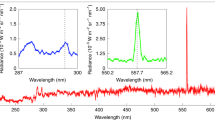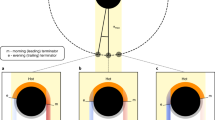Abstract
A PATROL spectrograph on loan from the U.S. International Geophysical Year Committee through the Air Force Cambridge Research Center has been operating at Invercargill since August 13, 1957. This spectrograph scans a 165° strip of sky along the spectral line, the strip of sky in this case lying along the geomagnetic meridian. With exposures of the order of four to five hours on the night sky, using film with Kodak 103a–F(3) emulsion, the spectrograph has recorded the red and green lines of atomic oxygen (6300 A. and 5577 A. of OI). A preliminary analysis of 220 spectra has been carried out for the period August 13–December 31, 1957.
This is a preview of subscription content, access via your institution
Access options
Subscribe to this journal
Receive 51 print issues and online access
$199.00 per year
only $3.90 per issue
Buy this article
- Purchase on Springer Link
- Instant access to full article PDF
Prices may be subject to local taxes which are calculated during checkout
Similar content being viewed by others
Author information
Authors and Affiliations
Rights and permissions
About this article
Cite this article
SANDFORD, B. Relative Intensities of the Oxygen Lines at 5577 A. and 6300 A. in the Night Sky. Nature 182, 42–43 (1958). https://doi.org/10.1038/182042b0
Issue Date:
DOI: https://doi.org/10.1038/182042b0
Comments
By submitting a comment you agree to abide by our Terms and Community Guidelines. If you find something abusive or that does not comply with our terms or guidelines please flag it as inappropriate.



